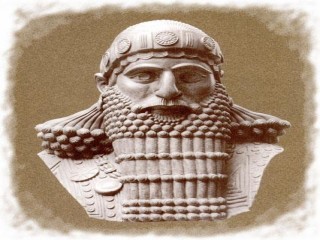
Hammurabi biography
Date of birth : -
Date of death : -
Birthplace : Babylonian Empire
Nationality : Babylonian
Category : Historian personalities
Last modified : 2011-05-28
Credited as : First Dynasty king , ,
Hammurabi (reigned 1792-1750 B.C.) was a Babylonian king. One of the outstanding rulers of early antiquity, he is especially known as a lawgiver, the author of the code which bears his name.
Nothing is known of the early life of Hammurabi. His name, sometimes written Khammurapikh, is West Semitic, and he was the sixth ruler of the Amorite dynasty founded by Shumu-Abum in 1894 B.C. On his accession Hammurabi inherited a kingdom of moderate size, one of a number of Mesopotamian city-states.
The first years of Hammurabi's reign were spent in consolidating his rule and in diplomatic maneuvers which strengthened his position; in alliance with Rim-Sin, king of neighboring Larsa, he repelled the Elamites from the eastern frontier, but in his thirtieth year he turned against his former ally; Rim-Sin capitulated, and Hammurabi became master of the south. He then conquered the kingdom of Mari, and in 1759 that city was razed by his orders. Eshnunna and Assyria soon fell to him as well.
These successes established Hammurabi as the leading power in western Asia. He controlled the trade routes to the west and may even have campaigned beyond the Euphrates, though the once popular identification of Hammurabi with "Amraphel, King of Shinar" (Genesis 14:9), does not nowadays find credence. His organization of the captured territories is known from letters he sent to his officials and the governors of provinces; these show him as an able administrator who supervised in person every aspect of his government.
The code of laws published by Hammurabi's order in every city of his realm has survived in several copies, the most complete being a stele of polished black diorite 8 feet high found at Susa, whither it had been carried by a later conqueror. The laws, originally 282 in number, do not form a complete code in the modern sense but are rather a series of enactments dealing with specific cases in which reform or clarification was needed.
They deal with a variety of subjects: marriage and inheritance, slavery, debt and usury, and the activities of trader, farmer, and tavern keeper. Compensation for specific injuries, the fees of surgeon and barber and veterinarian, a scale of punishments for assault and theft, the wages of laborers, and charges for the hire of boats and livestock are all laid down.
In the prologue to his code, the King declares his desire to "establish justice, " and at the end he declares that through his enactments "the strong shall not injure the weak, and the orphan and the widow shall receive justice." Although this was not a new concept—earlier compilations of laws are known—Hammurabi yet stands out as one of the great humanitarian figures of history.
The Code of Hammurabi is translated and edited, with a good commentary, by Godfrey R. Driver and John C. Miles in The Babylonian Laws (2 vols., 1952-1955). For a brief summary of the contents see James G. Macqueen, Babylon (1964). Leonard W. King, The Letters and Inscriptions of Hammurabi (3 vols., 1898-1900), is a selection of the correspondence, but the letters are widely scattered in later publications too numerous to enumerate.
















